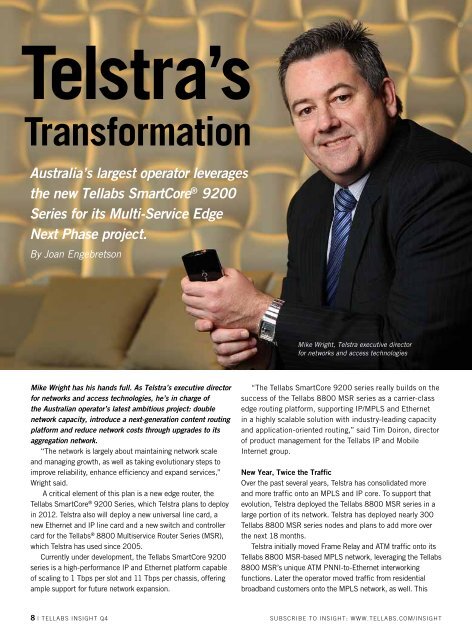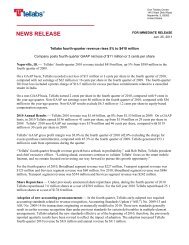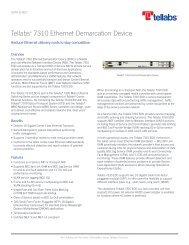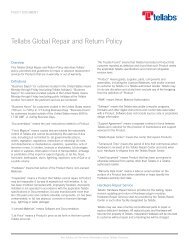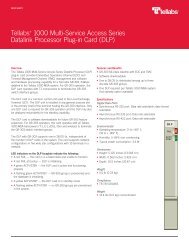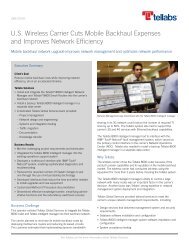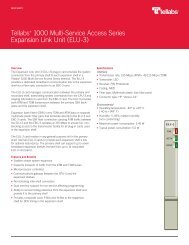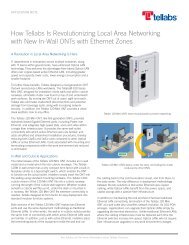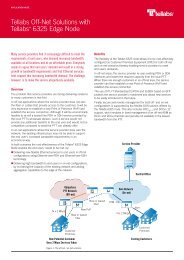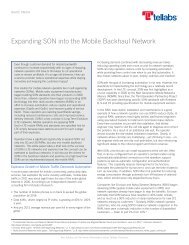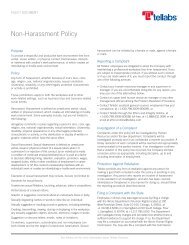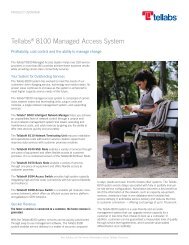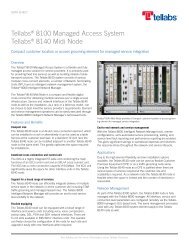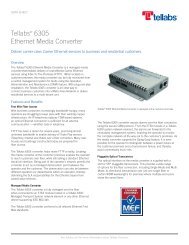Telstra's Transformation - Tellabs
Telstra's Transformation - Tellabs
Telstra's Transformation - Tellabs
You also want an ePaper? Increase the reach of your titles
YUMPU automatically turns print PDFs into web optimized ePapers that Google loves.
Telstra’s<br />
<strong>Transformation</strong><br />
Australia’s largest operator leverages<br />
the new <strong>Tellabs</strong> SmartCore ® 9200<br />
Series for its Multi-Service Edge<br />
Next Phase project.<br />
By Joan Engebretson<br />
Mike Wright, Telstra executive director<br />
for networks and access technologies<br />
Mike Wright has his hands full. As Telstra’s executive director<br />
for networks and access technologies, he’s in charge of<br />
the Australian operator’s latest ambitious project: double<br />
network capacity, introduce a next-generation content routing<br />
platform and reduce network costs through upgrades to its<br />
aggregation network.<br />
“The network is largely about maintaining network scale<br />
and managing growth, as well as taking evolutionary steps to<br />
improve reliability, enhance efficiency and expand services,”<br />
Wright said.<br />
A critical element of this plan is a new edge router, the<br />
<strong>Tellabs</strong> SmartCore ® 9200 Series, which Telstra plans to deploy<br />
in 2012. Telstra also will deploy a new universal line card, a<br />
new Ethernet and IP line card and a new switch and controller<br />
card for the <strong>Tellabs</strong> ® 8800 Multiservice Router Series (MSR),<br />
which Telstra has used since 2005.<br />
Currently under development, the <strong>Tellabs</strong> SmartCore 9200<br />
series is a high-performance IP and Ethernet platform capable<br />
of scaling to 1 Tbps per slot and 11 Tbps per chassis, offering<br />
ample support for future network expansion.<br />
“The <strong>Tellabs</strong> SmartCore 9200 series really builds on the<br />
success of the <strong>Tellabs</strong> 8800 MSR series as a carrier-class<br />
edge routing platform, supporting IP/MPLS and Ethernet<br />
in a highly scalable solution with industry-leading capacity<br />
and application-oriented routing,” said Tim Doiron, director<br />
of product management for the <strong>Tellabs</strong> IP and Mobile<br />
Internet group.<br />
New Year, Twice the Traffic<br />
Over the past several years, Telstra has consolidated more<br />
and more traffic onto an MPLS and IP core. To support that<br />
evolution, Telstra deployed the <strong>Tellabs</strong> 8800 MSR series in a<br />
large portion of its network. Telstra has deployed nearly 300<br />
<strong>Tellabs</strong> 8800 MSR series nodes and plans to add more over<br />
the next 18 months.<br />
Telstra initially moved Frame Relay and ATM traffic onto its<br />
<strong>Tellabs</strong> 8800 MSR-based MPLS network, leveraging the <strong>Tellabs</strong><br />
8800 MSR’s unique ATM PNNI-to-Ethernet interworking<br />
functions. Later the operator moved traffic from residential<br />
broadband customers onto the MPLS network, as well. This<br />
8 | <strong>Tellabs</strong> Insight Q4 subscribe to Insight: www.tellabs.com/insight
network also supports Ethernet services and mobile backhaul.<br />
Traffic on Telstra’s aggregation network has been growing<br />
dramatically. For example, the residential broadband portion<br />
doubles every 12 months.<br />
“We want to make sure we can continue to support strong<br />
traffic growth,” said Arturo Cacace, technology manager for<br />
Telstra’s Ethernet infrastructure and services. “We would like<br />
to expand our service offerings, enhance network reliability and<br />
efficiency and minimize costs.”<br />
Those requirements are driving Telstra’s newest upgrade,<br />
known internally as Multi-Service Edge (MSE) Next Phase,<br />
which aims to further enhance the carrier’s aggregation<br />
network according to a 2-phase plan.<br />
The first phase, known as MSE Gen 2, is already underway<br />
and scheduled for completion in early 2012. In MSE Gen 2,<br />
Telstra is introducing 3 new cards<br />
to the <strong>Tellabs</strong> 8800 MSR series<br />
that will double network capacity,<br />
improve reliability, significantly<br />
reduce cost per bit and add new<br />
capabilities for Ethernet service<br />
delivery.<br />
In the second phase, scheduled<br />
to begin in mid-2012, Telstra will<br />
deploy the <strong>Tellabs</strong> SmartCore<br />
9200 series, which expands on the<br />
capabilities of the <strong>Tellabs</strong> 8800<br />
MSR series.<br />
“We plan to use the <strong>Tellabs</strong><br />
SmartCore 9200 series to provide<br />
additional scalability, reliability and<br />
network efficiencies, ultimately reducing network costs,” said<br />
David Robertson, Telstra director for transport and routing<br />
engineering. “In addition, the <strong>Tellabs</strong> SmartCore 9200 series<br />
can provide a platform for next- generation services.”<br />
Change is in the Cards<br />
The <strong>Tellabs</strong> 8800 MSR series nodes, which are part of<br />
Telstra’s MPLS-based aggregation network, are today<br />
equipped with the <strong>Tellabs</strong> universal line card (ULC-2).<br />
Telstra now plans to upgrade trunks and spares to the ULC-<br />
3, a next-generation universal line card that has a revised ASIC,<br />
a faster CPU and more RAM. Telstra expects the ULC-3 to<br />
improve performance and increase network reliability.<br />
“By using the latest platform, we get better scale and<br />
reliability and lower unit cost,” Wright said.<br />
Telstra also plans to upgrade the switch and controller card<br />
(SCC-1) that is currently deployed in the <strong>Tellabs</strong> 8800 MSR<br />
series to a next-generation version of the card, the SCC-2.<br />
That upgrade will more than double chassis capacity, from<br />
120 GB to 288 GB. Slot capacity and Ethernet port density<br />
will double, as well.<br />
“We plan to use the <strong>Tellabs</strong><br />
SmartCore 9200 series to<br />
provide additional scalability,<br />
reliability and network<br />
efficiencies, ultimately reducing<br />
network costs. In addition,<br />
the <strong>Tellabs</strong> SmartCore 9200<br />
series can provide a platform<br />
for next-generation services.”<br />
— David Robertson, Telstra director for<br />
transport and routing engineering<br />
“Instead of the traditional hard disk drive, the SCC-2 uses<br />
solid-state storage,” said Andrew Roberts, a sales support<br />
engineer for <strong>Tellabs</strong> who has been closely involved in Telstra’s<br />
network upgrade plans. “That is one of the several design<br />
updates on SCC-2 that enhance network reliability.”<br />
The third new line card that Telstra will deploy is the<br />
Ethernet line card (ELC), which the carrier will use to support<br />
business Ethernet services. The new ELC is a more optimized<br />
way to deliver Ethernet with a higher density and lower price<br />
per port.<br />
The move to the ELC at this time makes sense for<br />
Telstra because of the strong growth the carrier is seeing<br />
in Ethernet services. “If you look at our growth statistics,<br />
the real explosion is in Ethernet, DSL and wireless,” Wright<br />
said. Using the ELC is a good move because the product<br />
represents “the latest generation<br />
technology with lower power<br />
consumption and lower unit cost.”<br />
Better Awareness,<br />
Enhanced Reliability<br />
Besides providing ample room for<br />
growth, the <strong>Tellabs</strong> SmartCore<br />
9200 series also gives Telstra some<br />
powerful new tools.<br />
“The <strong>Tellabs</strong> SmartCore 9200<br />
series incorporates application<br />
awareness and OA&M capabilities<br />
beyond Layer 3 to help service<br />
providers understand what user<br />
applications drive their network,”<br />
Doiron said. “Those insights enable them to both design<br />
accordingly and offer new revenue-generating opportunities.”<br />
Another capability of the <strong>Tellabs</strong> SmartCore 9200 series is<br />
built-in support for a 3G and LTE packet core. Although Telstra<br />
has no plans to adopt a packet core architecture immediately,<br />
the carrier likes the fact that the <strong>Tellabs</strong> SmartCore 9200<br />
series will enable it to easily add that capability in the future.<br />
The <strong>Tellabs</strong> SmartCore 9200 series also has several<br />
features aimed at enhancing reliability, including solid-state<br />
storage, the new <strong>Tellabs</strong> GeniOS carrier-grade operating<br />
system and a redesigned software architecture.<br />
“We’re always looking for the right time and opportunity<br />
to move to the next greater scale solution,” Wright said. A<br />
key driver of the planned deployment, Wright said, is “to<br />
put the latest generation of the <strong>Tellabs</strong> platform into our<br />
network and use it to drive the most flexibility and lowest<br />
cost moving forward.”<br />
The <strong>Tellabs</strong> SmartCore 9200 series “has a lot of optional<br />
features to build future products on,” Wright said. A content<br />
and security engine can provide the ability to “better<br />
understand how different customers are using the network<br />
Subscribe to Insight: www.tellabs.com/insight <strong>Tellabs</strong> Insight Q4 | 9
The Telstra team:<br />
David Robertson,<br />
director for<br />
transport and<br />
routing; Mark<br />
Latham, senior<br />
technology<br />
specialist; Arturo<br />
Cacace, technology<br />
manager.<br />
and over time, offer different service<br />
levels for different applications.” This<br />
functionality is built directly into the<br />
<strong>Tellabs</strong> SmartCore 9200 series’ line<br />
cards, enabling content inspection<br />
directly on line cards interfacing the<br />
network and making efficient use of<br />
precious chassis ports.<br />
To develop those services,<br />
“we want to understand how the<br />
network is used,” Wright said. By<br />
enabling operators to maintain and<br />
analyze aggregate data about the types of applications that<br />
customers are using, application awareness can help gain that<br />
understanding.<br />
Initially Telstra plans to deploy the <strong>Tellabs</strong> SmartCore 9200<br />
series in “high-density parts of the network, where scale is<br />
needed or where we are looking to drive new services, such<br />
as DPI-based services,” Wright said. “We will continue to use<br />
the <strong>Tellabs</strong> 8800 MSR series in areas where Ethernet growth<br />
requirements are not as explosive.”<br />
Familiarity Breeds Content<br />
Despite all of these upgrades, managing the new equipment<br />
should require minimal new training or procedures. That’s<br />
because Telstra will be able to manage its <strong>Tellabs</strong> network<br />
with a single, unified network manager for both the <strong>Tellabs</strong><br />
SmartCore 9200 series and the <strong>Tellabs</strong> 8800 MSR series.<br />
“We look at a lot of equipment from a lot of vendors,”<br />
Wright said. “One of the biggest factors we take into account<br />
as an operator is to maintain continuity in IT systems. <strong>Tellabs</strong>’<br />
“We want to make sure we<br />
can continue to support strong<br />
traffic growth. We also want to<br />
expand our service offerings,<br />
enhance network reliability and<br />
efficiency and minimize costs.”<br />
— Arturo Cacace, Telstra<br />
technology manager, Ethernet<br />
infrastructure and services<br />
manager makes integration easier and<br />
the decision to upgrade easier as well.”<br />
That continuity includes some<br />
familiar faces. The <strong>Tellabs</strong> Global<br />
Services team has supported several<br />
other major Telstra projects, including<br />
its Next IPTM network. (For more<br />
information about Next IP, visit www.<br />
tellabs.com/insight and check out<br />
“Another Step for Telstra’s Next IP<br />
Rollout” in the Q3 2011 Insight.) That<br />
relationship continues with the MSE Gen<br />
2 program and the <strong>Tellabs</strong> SmartCore 9200 series rollout.<br />
“By working closely with <strong>Tellabs</strong> Global Services, we can get<br />
the most out of the platform,” Wright said. “We benefit from<br />
having their experts working with us.”<br />
A team of <strong>Tellabs</strong> Global Services personnel is focused<br />
100% on Telstra and even have desks located in Telstra<br />
offices. This close collaboration helps <strong>Tellabs</strong> in mapping out<br />
the direction of future products, Wright said. By working closely<br />
with <strong>Tellabs</strong> Global Services on an ongoing basis, Wright said<br />
Telstra has “direct input into where the partnership is going and<br />
a direct feed into the product area at <strong>Tellabs</strong>.” •<br />
3G: Third Generation<br />
ASIC: Application-Specific<br />
Integrated Circuit<br />
ATM: Asynchronous<br />
Transfer Mode<br />
CPU: Central Processing Unit<br />
DSL: Digital Subscriber Line<br />
IP: Internet Protocol<br />
LTE: Long-Term Evolution<br />
MPLS: Multiprotocol<br />
Label Switching<br />
OA&M: Operations, Administration<br />
and Maintenance<br />
RAM: Random Access Memory<br />
TDM: Time Division Multiplexing<br />
10 | <strong>Tellabs</strong> Insight Q4 subscribe to Insight: www.tellabs.com/insight


